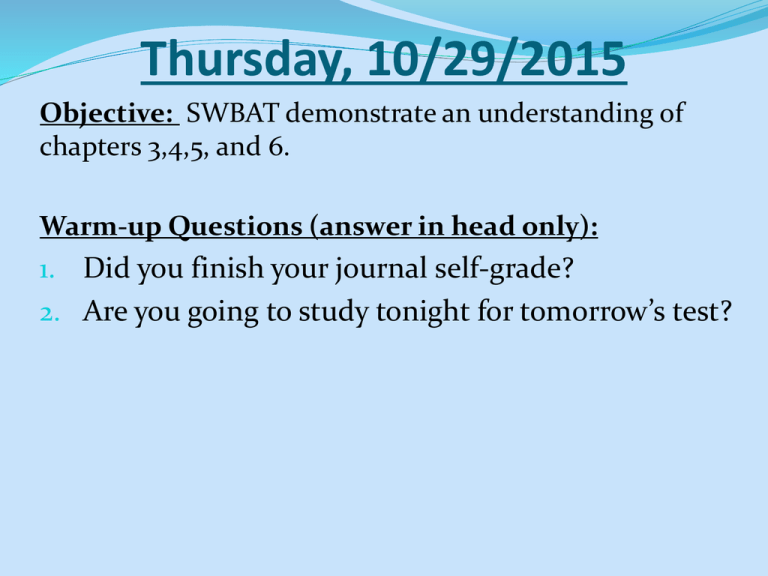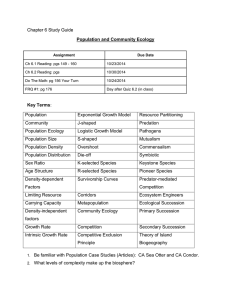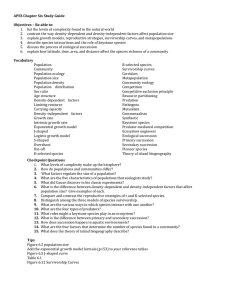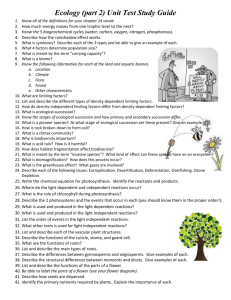Chapter 14 Review
advertisement

Thursday, 10/29/2015 Objective: SWBAT demonstrate an understanding of chapters 3,4,5, and 6. Warm-up Questions (answer in head only): 1. Did you finish your journal self-grade? 2. Are you going to study tonight for tomorrow’s test? Battle Royale-Style Battle Royale Rules! • Each person from your team will be up at the board one • • • • • • time. Each person from your team may go up to the board to assist someone one time. After that they may not be a helper for the remainder of the game. No direct communication between the group and the board. You must show your work with appropriate units for math problems. You must write in a complete, stand-alone sentence for explanations (IQIA). Lists must be written in order (answers only) The point will be awarded for the team with the correct, complete answer that puts their pen down first. Candy for the winning team!!! Let’s assemble teams! Team RIGHT: ? Team MIDDLE: ? Team LEFT: ? Rank in order (but not IQIA)! 1. Rank from least complex to most complex using the following ecological terms: biome, biosphere, community, ecosystem, population Population, community, ecosystem, biome, biosphere Draw a pretty picture! 2. Draw a food chain with at least four organisms. Label the following: carnivore(s), consumer(s), herbivore(s), producer(s) The first organism should be the producer, the second should be an herbivore, the third and fourth are carnivores; all but the producer are consumers. Arrows point from prey to predator. Answers in a complete sentence! 3. What is a difference between primary succession and secondary succession? Primary succession starts with bare rock and no soil and proceeds slowly. Secondary succession occurs after a disturbance or natural disaster; soil is still present and it proceeds faster. Draw a pretty picture! 4. Draw and label two graphs: one exponential growth curve and one logistic growth curve. Show work and include units! 5. A moose consumes 875,000 kilocalories during its lifetime. Calculate the number of calories that would be available to the gray wolf that eats it. 875,000 kilocalories*0.1 = 87,500 kilocalories Draw a diagram! 6. Draw a biological part of the carbon cycle using the following components: plants, animals, atmosphere. Label arrows to show processes. • Plants take CO2 through photosynthesis • Animals eat plants (and other animals) • Animals (and plants) release CO2 through cellular respiration Show your work (including units)! 7. In 1981 there were 410 ocelot on the island of Elba (100 square kilometers). A population biologist determined that 60 ocelots are born each year, 25 die each year, immigration is 2 each year and emigration is 7 each year. What was the population density the year Ronald Reagan was re-elected (1984)? N = 410 + (60-25+2-7)(3 years) = 500 ocelots D = N/area = 500 /100 = 5 ocelots/km2 Bonus Question Line your team members up in front of your space on the board in order from shortest to tallest. List your answers (not IQIA) 8. Identify each type of community interaction: a. Termites chew up wood; microorganisms in their gut digest it and provide nutrients Mutualism to termites. b. Cordyceps fungi hijack an insect’s brain and change its behavior before bursting of it Parasatism out and dispersing spores. c. Mosquitoes carry the malaria-causing protozoan without even knowing it. Commensalism Answer in complete sentences! 9. Compare and contrast invasive species from reintroduced species by describing one similarity and one difference. Similarities: introduced into an area Differences: invasives are non-native and reintroduced used to be there; invasives cause harm Rank in order (but not IQIA)! 10. Rank the following for least total biomass to greatest total biomass: Birds, insects, plants, spiders, tree snakes Tree snakes, birds, spiders, insects, plants (from top of trophic level to bottom) Answer in complete sentence 11. How are density-dependent limiting factors different from density-independent limiting factors? Density-independent factors affect a population regardless of its size; densitydependent factors have larger effects as the population size increases List and label answers (not IQIA) 12. You want to know if studying improves grades. To test this you take 50 sophomores with the same GPA (3.0) and have half of them review biology concepts using flashcards for 10 minutes a day; the other students do not (they play Pacman instead). You will compare the average test scores of the two groups. Identify the manipulated variable, responding variable, and two controlled variables. MV = activity (studying/pacman) RV = average test score CVs = GPA, sophomores, time of activity, same test You must answer in complete sentences! 13. What is a validity measure? A validity measure is a step taken during an experiment to ensure that the data collected shows what it is supposed to show. For example, calibrating equipment, washing glassware and running positive/negative controls are all validity measures.








